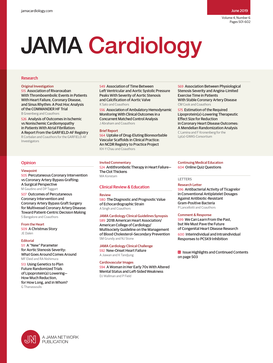Physiology-Guided Complete Revascularization in Older Patients With Myocardial Infarction
IF 14.1
1区 医学
Q1 CARDIAC & CARDIOVASCULAR SYSTEMS
引用次数: 0
Abstract
ImportanceComplete revascularization in older patients with myocardial infarction (MI) and multivessel disease has been shown to reduce cardiovascular death and MI at 1 year. However, the durability of this benefit over longer follow-up periods has been questioned by recent studies.ObjectiveTo determine whether the benefit of physiology-guided complete treatment, compared with culprit-only treatment, is sustained at 3 years in older patients with MI and multivessel disease.Design, Setting, and ParticipantsThis randomized clinical trial, Functional Assessment in Elderly MI Patients With Multivessel Disease (FIRE), was an investigator-initiated, multicenter, prospective, superiority trial conducted at 34 centers across 3 countries from July 18, 2019, to October 25, 2021. Participants were patients with MI (either ST segment or non–ST segment elevated) and multivessel disease who were hospitalized after successful treatment of the culprit lesion. Major exclusion criteria included a nonculprit lesion in the left main coronary artery and unclear identification of the culprit lesion. Data analysis was performed from March to May 2025.InterventionsCulprit-only treatment or physiology-guided complete revascularization of nonculprit lesions.Main Outcomes and MeasuresThe primary outcome was a patient-oriented composite end point of death, MI, stroke, or ischemia-driven revascularization. Secondary end points included a composite of cardiovascular death or MI and rate of heart failure hospitalizations.ResultsAmong 1445 patients enrolled in the trial, the median (IQR) age was 80 (77-84) years; 917 patients were male (63.5%) and 528 female (36.5%). At 3 years, the primary outcome occurred in 165 patients (22.9%) in the physiology-guided complete revascularization group and 216 patients (29.8%) in the culprit-only group (hazard ratio [HR], 0.72; 95% CI, 0.58-0.88;生理引导下老年心肌梗死患者的完全血运重建术
老年心肌梗死(MI)和多血管疾病患者的完全血运重建术已被证明可降低1年内心血管死亡和MI。然而,最近的研究对这种益处在较长随访期内的持久性提出了质疑。目的确定在老年心肌梗死合并多血管疾病患者中,与单纯的罪魁祸首治疗相比,生理引导下的完全治疗的益处是否能持续3年。设计、环境和参与者这项随机临床试验名为老年心肌梗死合并多血管疾病患者的功能评估(FIRE),是一项研究者发起的、多中心、前瞻性、优势试验,于2019年7月18日至2021年10月25日在3个国家的34个中心进行。参与者是心肌梗死(ST段或非ST段升高)和多血管疾病患者,他们在成功治疗了罪魁祸首病变后住院。主要的排除标准包括左冠状动脉主干的非罪魁祸首病变和罪魁祸首病变识别不清。数据分析时间为2025年3月至5月。介入治疗:非罪魁祸首病变的纯雕刻治疗或生理引导的完全血运重建术。主要结局和测量主要结局是一个以患者为导向的复合终点,包括死亡、心肌梗死、卒中或缺血驱动的血运重建。次要终点包括心血管死亡或心肌梗死和心力衰竭住院率。结果在1445例入组患者中,中位(IQR)年龄为80(77-84)岁;其中男性917例(63.5%),女性528例(36.5%)。3年时,生理引导的完全血运重建术组有165例(22.9%)患者出现主要结局,单纯罪魁祸首组有216例(29.8%)患者出现主要结局(风险比[HR], 0.72; 95% CI, 0.58-0.88; P = 0.002)。生理引导的完全血运重建术组(132例[18.2%])发生心血管死亡或心肌梗死这一关键次要结局的患者数量(92例[12.8%])明显低于单纯罪魁祸首组(132例[18.2%]);HR为0.66;95% CI为0.50-0.88;P = 0.004)。与生理引导的完全组相比,罪魁祸首组因心力衰竭住院的频率更高(143[19.7%]对103 [14.3%];HR, 0.73; 95% CI, 0.54-0.97; P = .03)。在75岁或以上的心肌梗死和多血管疾病患者中,生理引导的完全血运重建术比单纯的罪魁祸首病变治疗的益处持续了3年。临床试验注册号:NCT03772743
本文章由计算机程序翻译,如有差异,请以英文原文为准。
求助全文
约1分钟内获得全文
求助全文
来源期刊

JAMA cardiology
Medicine-Cardiology and Cardiovascular Medicine
CiteScore
45.80
自引率
1.70%
发文量
264
期刊介绍:
JAMA Cardiology, an international peer-reviewed journal, serves as the premier publication for clinical investigators, clinicians, and trainees in cardiovascular medicine worldwide. As a member of the JAMA Network, it aligns with a consortium of peer-reviewed general medical and specialty publications.
Published online weekly, every Wednesday, and in 12 print/online issues annually, JAMA Cardiology attracts over 4.3 million annual article views and downloads. Research articles become freely accessible online 12 months post-publication without any author fees. Moreover, the online version is readily accessible to institutions in developing countries through the World Health Organization's HINARI program.
Positioned at the intersection of clinical investigation, actionable clinical science, and clinical practice, JAMA Cardiology prioritizes traditional and evolving cardiovascular medicine, alongside evidence-based health policy. It places particular emphasis on health equity, especially when grounded in original science, as a top editorial priority.
 求助内容:
求助内容: 应助结果提醒方式:
应助结果提醒方式:


